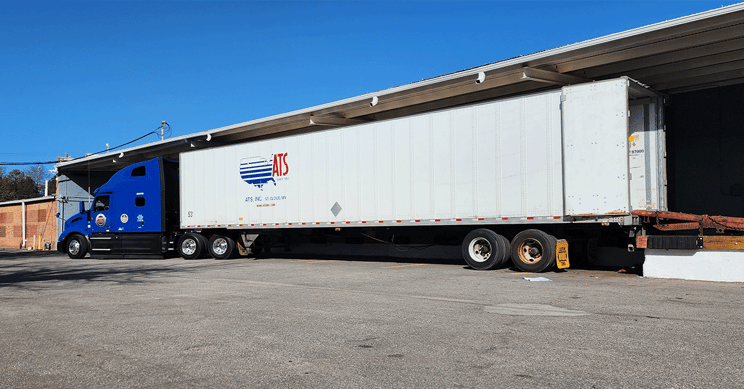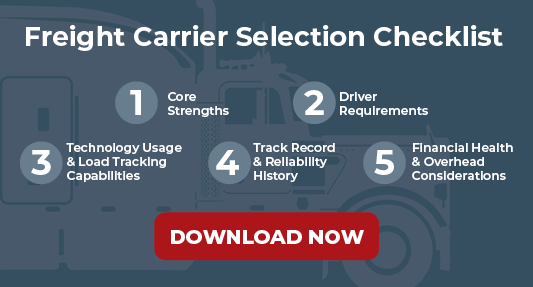Dry vans, those rectangular trailers with a double door in the back, are a common sight along roads and highways. They are one of the most popular vehicles used in the trucking industry, making them readily available and generally affordable.
If you’ve never had cargo shipped via dry van before, it may be unnerving to trust the carrier that they are making the best choice for you. Here at Anderson Trucking Service (ATS), we have hundreds of dry vans on the road at any time. This introductory post will help you understand dry vans and whether they are the best shipping option for your needs.
What Are Dry Vans?
Dry vans haul non-perishable dry goods from their point of origin to their final destination.
Typical dry vans have a wooden interior. They are not temperature or humidity controlled, making them suitable for shipping non-perishables that do not require special handling.
Most items hauled in a dry van are packed in cartons, in crates or on pallets. Goods commonly carried via dry van include:
- Clothing and shoes
- Retail and household goods
- Furniture
- Canned and non-perishable food
- Garden supplies
- Equipment and machinery
- Electronics

Large retailers, trucking companies and manufacturers across the country are just a few examples of frequent dry van shippers, using dry vans to haul between warehouses and stores.
Is My Freight Suitable for Dry Van Transport?
While they are one of the most common types of trailers, dry vans are not suitable for every application. Use these three criteria to determine if a dry van is the best method for hauling your commodity.
1. Is it temperature sensitive?
Dry vans are not temperature controlled. Depending on the route and time of year, the inside of the vehicle can experience extreme heat or extreme cold. If your freight will not be impacted by potentially large swings in temperature or humidity, a dry van may be a good option.
Refrigerated trucks (reefers) are available for freight that requires a consistent temperature. If your freight will require temperature control, you may need to compare dry vans and refrigerated trucks.
2. Will it fit inside the box?
The interior dimensions of a dry van are 8-feet, 6-inches wide by 8-feet, 6-inches tall and either 48- or 53-feet long. The freight must fit within these dimensions to be transported via dry van. When calculating how much inventory you can fit in a dry van, remember that these versatile vehicles can be loaded in multiple configurations, which may allow you to fit more than originally planned.
3. Can it be loaded without heavy equipment?
Dry vans are enclosed on the sides and top. All freight must be loaded through the back doors, usually manually or using a forklift or pallet jack. Loading docks align with the back of a dry van to simplify loading and unloading.
If your commodity must be loaded from the top or side with a crane or heavy equipment, consider a flatbed or conestoga trailer.
What Are the Advantages of Dry Van Trucks?
There are multiple reasons dry vans have become so popular for transport. They are versatile and reliable, and standardized to make them easy for drivers to use. Here are three of the largest advantages of shipping via dry van trailer:
- Plentiful supply means affordable pricing
- Interior is protected from the elements
- Designed to fit legal loads nationwide
1. Plentiful Supply Means Affordable Pricing
Many carriers have an expansive fleet of dry vans. Retailers and manufacturers often have their own fleet of branded dry vans.
At any time there are thousands of dry vans on the road. Many of these will soon be looking for a load to haul to the next destination. This means there is usually a dry van trailer available for your full-truckload shipment and at an affordable price.
2. Interior Is Protected From the Elements
Dry vans are fully enclosed with solid metal-and-wood walls and ceiling. This protects your freight from rain, snow, hail, sand, debris, bugs and other elements that can damage or dirty your commodity, and it saves on the cost of tarping.
The interior of a dry van is also enclosed and invisible to the public. This protects your freight from curious eyes and potential theft. Your driver will seal the freight shut when it is loaded and leave it sealed until it is safely with your consignee for ultimate protection from theft.
3. Designed to Fit Legal Loads Nationwide
Dry vans are sized to fit within legal full-truckload limits nationwide, without additional permitting, pilot cars or other pre-planning. This simplifies your trip and saves on the time and cost required to obtain additional permits.
Of course, there is no one right solution for shipping. That is why many carriers are equipped with multiple trailer types to meet your specific needs.
Common Problems with Dry Van Shipping
The vast majority of dry van trips will be uneventful and proceed exactly as planned. But occasionally, there are problems. This includes the following three common dry-van shipping downsides:
1. Limited Capacity
Dry vans have a finite capacity. Unlike some other types of transit, such as flatbed trailers, there is no way to permit a dry van to carry oversize cargo. If the commodity doesn’t fit within the size of the box, you will need to find another way to haul.
Like all trailers, dry vans also have a weight limit. A fully loaded van can carry about 45,000 lbs.
2. No Temperature Control
Unlike refrigerated trucks, there is no way to control the interior temperature and conditions within a dry van. If you need to control temperature and humidity, your carrier should provide another type of vehicle.
3. Jostling of Contents
During shipping, some movement and jostling of contents can occur. Most dry vans have e-tracks and logistics posts that drivers use to secure your freight, which will minimize the impact of movement during transit. Properly packing and insulating your goods is another layer of protection you should consider when choosing a shipping method, as there is no mode of transportation that will keep your commodity completely safe from jostling.
If you aren’t sure if dry vans are the best way of shipping your freight to its final destination, your carrier can help you evaluate which type of vehicle will work best.
Alternatives to Dry Van Shipping
There are some specialized truck and trailer combinations that may be better for hauling your commodity. Here are four alternatives to consider:
1. Refrigerated Trucks
Commodities that require temperature control may be better transported in a refrigerated truck, also known as a reefer. As the name implies, refrigerated trucks are insulated and have a refrigeration unit that keeps its interior at a consistent temperature.
Refrigerated trucks are commonly used for transporting groceries and other perishable items. They may also be used for hauling freight above the frost-line during the winter.
When more dry vans are needed, reefers can help. In some cases, the refrigeration unit can be turned off and the truck turned into a dry van.
2. Vented Van Trailers
Commodities that require air circulation but not necessarily a certain temperature (including hearty vegetables like potatoes and onions) are commonly transported in a vented van trailer.
As the name implies, vented vans have air vents at the front and back for airflow. While this isn’t a fully temperature-controlled method of transportation, it can circulate cooler air throughout the vehicle on hot days. For further protection, the driver will close the vents as needed during rain and precipitation.
3. Flatbed Trucks
Flatbeds are unenclosed, open-deck trailers that pull behind the truck. Flatbeds are available in several heights and trailer configurations to legally accommodate different types of freight. Commodities hauled on a flatbed are open to the elements, but they can be loaded via crane or permitted as an oversize load.
4. Conestoga Trailers
Conestoga trailers are flatbed trailers with retractable curtain walls. Like dry vans, Conestoga trailers keep the freight enclosed during transit and are limited by the size of the interior. They do not need tarping for additional protection from the elements.
Conestoga trailers are often chosen over dry vans because they can be loaded from the side using a crane or other heavy equipment. The curtain sides of Conestoga trailers are not as solid as dry van walls, so freight that will slide around or press against the sides may be better suited for a dry van. Because Conestoga trailers are less common, they are typically the more expensive option.
What to Look for When Shipping Via Dry Van
Dry vans are easy to find and available through nearly all carriers. But checking for a few factors will help your cargo have the safest, smoothest trip possible. Here’s what you need to consider:
- The condition of the trailer
- Trailer seals and safety equipment
- Carrier experience
Condition of the Trailer
The condition of the trailer is critical when it comes to the condition of your commodity at the destination. Holes or cracks in the trailer may let in moisture. Lack of tie downs may mean your cargo slides around more inside the trailer, leaving it vulnerable to bumps and scrapes.
Depending on what you are shipping, the condition of the trailer and exposure to the elements may or may not be a vital consideration. If you are hauling sturdier freight on an older trailer, you may be able to negotiate a lower price due to the condition of the trailer.
Trailer Seals and Safety Equipment
Trailer seals are affixed outside of a trailer when it is fully packed at the point of origin. Trailer seals give you peace of mind that no one has tampered with your freight. If your driver or shipping company is unable to provide basic safety measures like this, ask questions to determine what security they provide and make sure you feel safe sending your commodity with them.
Carrier Experience
Be sure to vet the carrier before trusting them with your load. Find out how long they have been in business, the age of their fleet, driver experience and their history of hauling commodities like yours. You are entrusting your valuable assets to this company, and it’s important you feel comfortable with your carrier partner.
Choosing a Dry Van Carrier
While it can be nerve-wracking to trust your valuable freight to a carrier, understanding the pros, cons and capabilities of common shipping methods can help ease your mind. Before you ship your first load, be sure to work with your carrier to understand what type of vehicle they will be using and why, as well as what factors impact the price of your dry van shipment.






